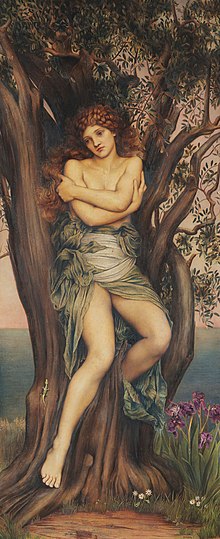Dryad

A dryad (
Types
| Greek deities series |
|---|
| Nymphs |
Daphnaie
These were nymphs of the laurel trees.
Epimelides
The Maliades, Meliades or Epimelides were nymphs of apple and other fruit trees and the protectors of sheep. The Greek word melas, from which their name derives, means both apple and sheep. Hesperides, the guardians of the golden apples were regarded as this type of dryad.
Hamadryad
Dryads, like all
Meliae
The dryads of the
Names
Some of the individual dryads or hamadryads are:
- Atlanteia and Phoebe, two of the many wives or concubines of Danaus[3]
- Chrysopeleia[4]
- Dryope[5]
- Erato[6]
- Eurydice
- Tithorea[7]
In popular culture

- Keats addresses the nightingale as "light-winged Dryad of the trees", in his "Ode to a Nightingale" .
- In the
- Dryad's figure in
- In Lev Grossman's The Magicians Trilogy, the character Julia becomes a dryad after having had her shade removed during her rape at the hands of Reynard the Fox. Her transformation accelerates when she visits Fillory in the company of the novel's other principals, and is complete when she and Quentin Coldwater visit Fillory's underworld.[10]
- The fantasy novels of Thomas Burnett Swann frequently feature dryads, along with other mythological creatures, usually endangered by the advent of more "advanced" civilisations. Swann's story "The Dryad-tree" is set in contemporary Florida and features a woman's reaction to the knowledge that her new husband's garden contains a tree possessed by a jealous dryad. The story was adapted as a short film in 2017.[11]
See also
- Oreads, a related mountain nymph
- Ghillie Dhu, a similar Scottish spirit
- Kodama, a similar Japanese spirit
- Green spirit, a similar spirit found in Myanmar and other Buddhist countries
- Elf, a similar mythical creature associated with nature
- Querquetulanae, Roman nymphs of the oak
- Rådande, a similar Swedish spirit
- Salabhanjika, a similar Indian spirit
- Mavka, a similar Ukrainian spirit
References
Citations
- ^ a b c Graves, ch. 86.2; p. 289
- ^ "Nymphs | Theoi Greek Mythology". www.theoi.com. Retrieved 2022-06-13.
- ^ Apollodorus, 2.1.5
- Tzetzes on Lycophron, 480
- ^ Ovid, Metamorphoses 9.330 ff; Antoninus Liberalis, 32
- ^ Pausanias, 8.4.2
- ^ Pausanias, 10.32.9
- JSTOR 20077624.
- ^ Dryad: Mythical Creature Overview, Mythical Encyclopedia, accessed 16 April 2024
- ISBN 978067002231-1
- ^ "The Dryad Tree (2017) - IMDb". IMDb. Retrieved 25 August 2018.
Bibliography
- ISBN 0-14-001026-2.
- Burkert, Walter, 1985. Greek Religion (Cambridge: Harvard University Press).
External links
- Greek Mythology Link: Nymphs.
- Hans Christian Andersen, "The Dryad", 1868 (e-text)
- Andersen, H. C.; Craigie (transl.) "The Dryad" Fairy tales and other stories London; Toronto: Oxford University Press. 1914
- Tim Hoke, "The Dryad", 2002 (e-text; strong language)
